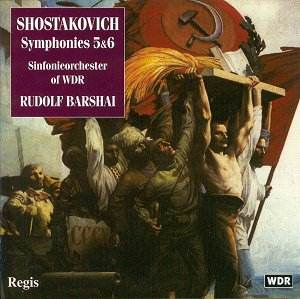It is fairly easy to understand why Shostakovich’s
Symphony No.5 in D minor Op.47 has become one of his most
popular and most recorded works. It has all the ingredients that make
a great piece of art of wide appeal: it alternates humour, irony, lyricism,
outgoing optimism and the epic. The first movement opens with an impassioned
declamatory paragraph of mounting tension released in the dramatic,
war-like section. The tension of the first movement is offset by the
often ironic jollity of the Mahlerian Scherzo. The darkly brooding Largo
is, as far as I am concerned, one of Shostakovich’s finest symphonic
movements. The Finale is again in a jocular mood, though things are
never as simple as that in Shostakovich’s music. Indeed, the Fifth Symphony
(sometimes subtitled "A Soviet Artist’s Reply to Just Criticism")
is a remarkable example of Shostakovich’s often ambiguous attitude vis-à-vis
the Stalinist regime. Viewed superficially, it may be said to adhere
(i.e. to a certain extent) to Socialist Realism’s dictates. Evil forces
are eventually vanquished thanks to Stalin’s enlightened leadership.
With some historical insight, now possible, it might have been a harsh
criticism of Stalinism as well. On the other hand, it may simply be
an abstract piece of music on an epic scale on which Mahler’s shadow
looms large. Whatever the interpretation, the Fifth Symphony is a big
piece that succeeds through the sheer force of its symphonic argument,
the memorability of the thematic material and the superb scoring.
In stark contrast, the Symphony No.6 in B minor
Op.54 is one of his least-known works. Its structure is quite
unusual in that it consists in a very long Largo followed by two short
Scherzi (Allegro and Presto). Shostakovich is said to
have been particularly happy with the final Presto which he considered
his finest and most successful Finale. He also mentioned that he wanted
"to convey the moods of spring, joy, youth" and firmly believed
that this symphony contained nothing subversive at all that could disturb
the regime’s authorities. Well, the opening Largo does not really
fit in here. It is an intensely tragic, brooding, doom-laden meditation,
probably on the composer’s own solitude at that time. The jollity of
the Scherzi also has its shares of irony and bitter-sweet melancholy,
and may not be easily reconciled with the composer’s supposed intent.
However, in spite of its lack of popularity, the Sixth Symphony is a
powerful statement in its own right.
Dave Billinge has recently
reviewed Barshai’s complete recording of Shostakovich’s symphonies
(MusicWeb – June reviews) and I will add nothing to his comments with
which I fully agree. Barshai had a long association with Shostakovich’s
music which he thoroughly understands. The present warmly recommended
readings of the Fifth and Sixth Symphonies with the WDR orchestra in
top form are really very fine.
Hubert Culot
Extract from Dave Billinge's review of the complete
set
The 5th is given a very powerful opening
by the strings with a brilliantly penetrating piccolo and a nicely audible
piano. I also noted the horns were suitably ominous. A slight miscalculation
of balance leads the solo violin to sound from the back of the firsts
rather than the front but this is minor. Apart from the excellent ensemble
displayed in this work I was mainly pleased by Barshai’s observing of
an appropriately slow tempo for the "exultant" coda which
Shostakovich once described thus: "It is as if someone were beating
you with a stick and saying, ‘Your business is rejoicing, your business
is rejoicing,’ and you rise, shaky, and go marching off, muttering,
‘Our business is rejoicing, our business is rejoicing.’" (Testimony)
This is a good 5th but I still would not be without Maxim
Shostakovich (Collins nla) or Sanderling (Berlin Classics).
In opening of the 6th there is again an
unerring choice of the right tempo, which, with the very impressive
horns, imparts a real heroic quality. The balance between string, wind
and brass choirs is very well judged and the impression is given of
separate threads developing in parallel; a real "large scale integration
of contrasts" as such a symphony should be. The WDR Orchestra give
such a good impression of being a Russian orchestra with pungent wind
playing and powerful brass. What marks them out from most Soviet performances
is that they are so well recorded. The string playing in this 6th
is really magnificent. This is as good a performance of the Largo as
I have ever heard. The wildness of the 2nd and 3rd
movements come as even more of a shock after such intensity. The Allegro
opens with utmost delicacy, everything very precisely pointed. Brilliantly
done, if not as exciting as some I have heard. The finale is again not
as fast as some but done with such fierce precision as to make it sound
even angrier. There could, I accept, be more abandon, but this is outstandingly
good..
Dave Billinge


